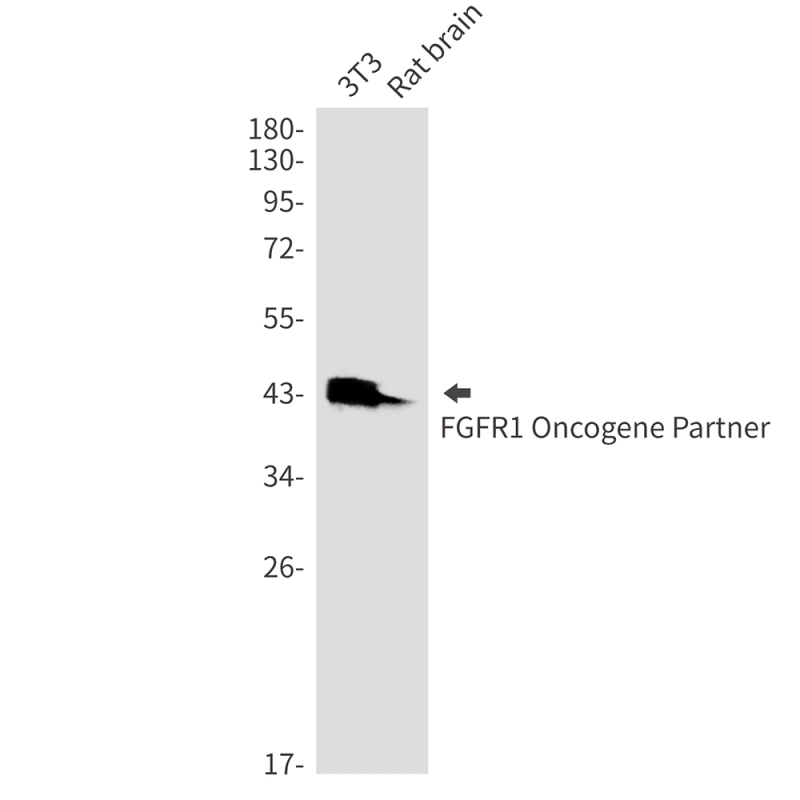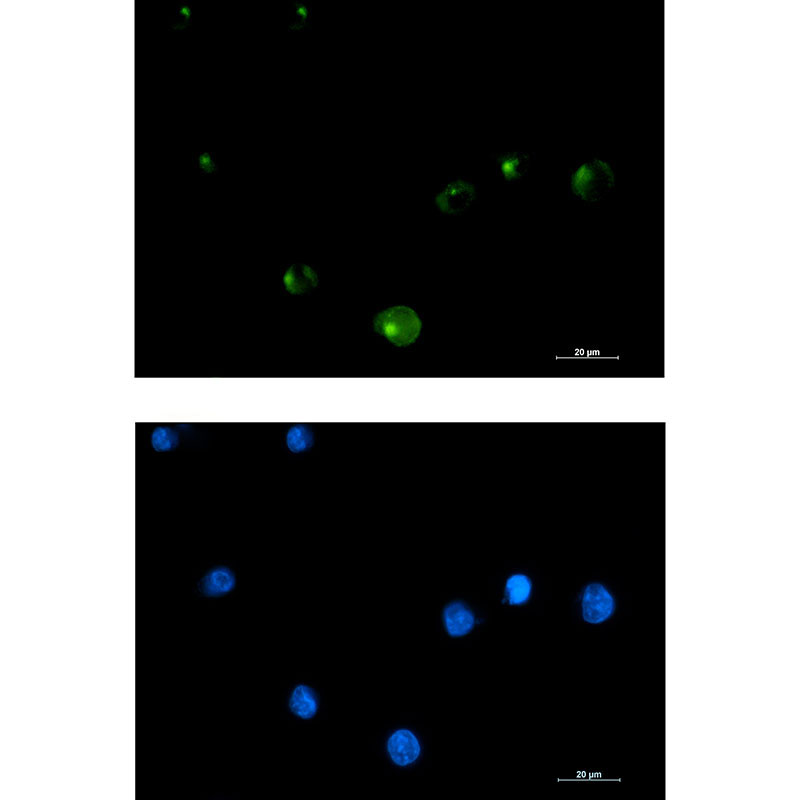


| WB | 1/500-1/1000 | Human,Mouse,Rat |
| IF | 1/20 | Human,Mouse,Rat |
| IHC | 咨询技术 | Human,Mouse,Rat |
| ICC | 1/50-1/200 | Human,Mouse,Rat |
| FCM | 咨询技术 | Human,Mouse,Rat |
| Elisa | 咨询技术 | Human,Mouse,Rat |
| Aliases | FOP; FGFR1OP |
| Entrez GeneID | 11116 |
| WB Predicted band size | Calculated MW: 43 kDa; Observed MW: 43 kDa |
| Host/Isotype | Rabbit IgG |
| Antibody Type | Primary antibody |
| Storage | Store at 4°C short term. Aliquot and store at -20°C long term. Avoid freeze/thaw cycles. |
| Species Reactivity | Human,Mouse,Rat |
| Immunogen | A synthetic peptide of human FGFR1 Oncogene Partner |
| Formulation | Purified antibody in TBS with 0.05% sodium azide,0.05%BSA and 50% glycerol. |
+ +
以下是关于FGFR1融合基因抗体应用的参考文献摘要,按研究背景与内容整理:
1. **《Recurrent fusion of the zinc finger gene ZNF198 to FGFR1 in myeloproliferative syndromes》**
- 作者:Smedley D, et al.
- 期刊:Blood (1998)
- 摘要:研究报道了ZNF198与FGFR1的融合基因在骨髓增生异常综合征中的作用,通过抗ZNF198和抗FGFR1抗体进行免疫共沉淀实验,证实了融合蛋白的异常表达及其致癌机制。
2. **《Structural characterization of the ZNF198-FGFR1 oncoprotein》**
- 作者:Xiao S, et al.
- 期刊:Oncogene (2001)
- 摘要:利用特异性抗体分析ZNF198-FGFR1融合蛋白的结构,揭示其通过二聚化激活FGFR1激酶活性,抗体检测显示融合蛋白在白血病细胞中的稳定表达。
3. **《The 8p11 myeloproliferative syndrome: a distinct clinical entity caused by constitutive FGFR1 activation》**
- 作者:Macdonald D, Cross NC
- 期刊:Leukemia (2004)
- 摘要:临床研究总结了8p11综合征中多种FGFR1融合基因(如BCR-FGFR1),通过抗体检测融合蛋白在患者样本中的表达,强调了靶向治疗的可能性。
4. **《Diverse mechanisms of oncogenic activation in FGFR1 fusion genes drive hematological malignancies》**
- 作者:Roumiantsev S, et al.
- 期刊:Journal of Biological Chemistry (2006)
- 摘要:比较不同FGFR1融合基因(如FOP-FGFR1)的致癌机制,使用抗体进行Western blot和免疫荧光分析,阐明融合蛋白的亚细胞定位及信号通路异常。
注:以上文献均涉及针对FGFR1融合伴侣(如ZNF198、BCR)的特异性抗体应用,涵盖蛋白检测、机制研究与临床关联分析。实际引用时建议核对最新数据库(如PubMed)以确保准确性。
The FGFR1 oncogene partner antibody is designed to detect proteins associated with chromosomal translocations involving the fibroblast growth factor receptor 1 (FGFR1) gene, a key driver in certain cancers. FGFR1. a tyrosine kinase receptor, becomes oncogenic when fused with partner genes (e.g., ZMYM2. BCR, FGFR1OP) due to chromosomal rearrangements, leading to constitutive kinase activation and uncontrolled cell proliferation. These fusions are hallmark features of hematologic malignancies like 8p11 myeloproliferative syndrome and rare solid tumors.
The antibody specifically targets epitopes within the fusion proteins formed by FGFR1 and its partners, enabling researchers to identify and study these aberrant oncoproteins. It aids in diagnosing translocation-associated cancers, assessing tumor biology, and evaluating therapeutic responses. By detecting FGFR1-partner interactions, the tool also supports research into downstream signaling pathways (e.g., MAPK, PI3K/AKT) and mechanisms of oncogenic transformation.
Clinically, FGFR1 fusion detection informs targeted therapy strategies, including kinase inhibitors. However, antibody specificity varies depending on the partner gene region recognized, requiring validation for each fusion variant. Overall, this reagent is pivotal for both basic research and translational applications in FGFR1-driven malignancies.
×